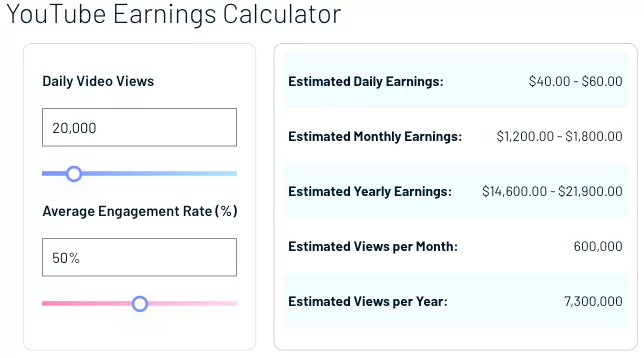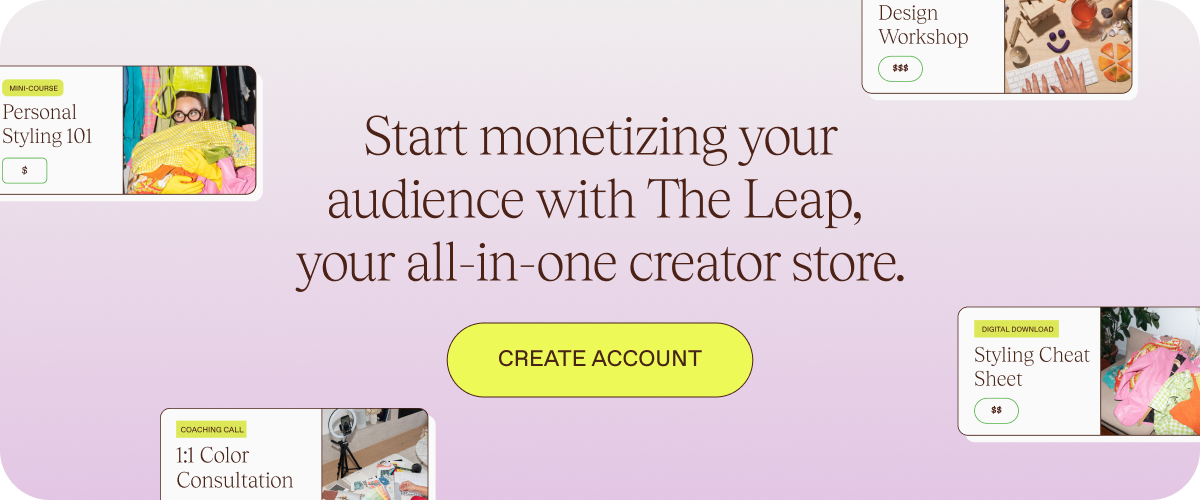Content monetization is a way of leveraging content so that, when users consume it, you earn money. You can be paid either by the users themselves, or a third party that markets products through your content.
Subscriber-only access and online courses are the most common and effective ways to get paid directly by users. Affiliate marketing, product placement, and pay-per-click (PPC) ads are the most common ways to get paid by third parties.
We’ll cover all these methods—and more—in this guide. We’ll also dig into the specifics of monetizing Facebook and monetizing YouTube.
- Who should monetize their content?
Three ways to monetize your content
Content monetization through advertisements
Content monetization platforms
Three major mistakes to avoid monetizing content
But first—is content monetization the right choice for you?
Who should monetize their content?
It’s easy to begin experimenting with content monetization. For instance, platforms like YouTube and Facebook already have built-in services that let you benefit from PPC ads once your engagement reaches a certain threshold.
If you…
-
Are knowledgeable and experienced in a certain niche
Already run a content platform—whether a blog, YouTube channel or social media account—that you’re passionate about
Get a lot engagement from your followers, and can see a growth in new followers
Have capacity to spend more time working on your platform, in return for earnings
…Then content monetization could be a great side hustle—or even a full-time gig for you.
Keep in mind, you don’t need to be engaged in a “sexy” niche; not everyone who earns money from content runs a luxury lifestyle brand. Plenty of recipe bloggers, piano instructors, and crocheting grandmas earn extra income by monetizing their content.
Don’t believe us? Check out this TikTok monetization calculator to see how much a TikTok account can earn based on its followers and engagement.
Three ways to monetize your content
When you’re monetizing your content the models don’t always complement each other.
Someone is either paying you for your content directly, or they’re paying for access to your audience. By understanding this, you can choose the best content monetization model for your business.
-
When you sell your content, you earn money directly from users. For instance, when content is behind a paywall, or structured into an online course, you’re selling your product.
When you’re selling your audience, you’re working with a third party to fulfill their marketing needs. Think of the “word from our sponsors” part of your favorite podcast, or the links in your favorite recipe blog that lead to Amazon products. These are examples of selling your audience.
Keep in mind, however, that selling your audience necessarily lowers the quality of your content.
Let’s face it: Ads, affiliate links, and sponsorship messages don’t make your work better. They earn you money, but if it weren’t for that, you probably won’t use them. As selective, and authentic you may try to be, they ultimately take away from your content’s quality, rather than improving it. If you have the option, you may wish to explore ways to sell your content directly to your audience first.
Once you’ve chosen what to sell, you have four content monetization models to choose from: 3rd party ads, premium content, content monetization platforms, and monetizing your fan base.
| What is your product? | Who is your customer? | |
| Third Party Ads | Your audience | Advertisers |
| Premium Content | Your content | Your content consumer |
| Content Monetization Platforms | Your audience | Youtube or Facebook |
Advertising
When you sell your audience to advertisers, you get paid to direct them to the product being advertised: By including it in your content (product placement); by linking to it in your content, or directing your audience to a custom landing page (affiliate marketing); or by including ads with your content (PPC advertising).
Premium content
When you sell premium content, you’re selling it directly to your audience. Typically, audience members already enjoy the content you create for free. The premium model lets them pay to access exclusive content they wouldn’t get otherwise.
Content monetization platforms
Content monetization platforms like Facebook and Youtube act like a third party between you and advertisers. You publish your content on a platform, and the platform pays you to run ads. (The platform, in turn, is paid by the advertisers.) If you mostly publish your content on a social network, this is the easiest, most direct way to start monetizing it.
Monetizing your fanbase
To monetize your fanbase, you create new products to sell to people who love your work. T-shirts, mugs, throw pillows—these are all fairly straightforward options. You may also launch a Patreon, either to take donations or offer exclusive content. In this way, monetizing your fanbase sometimes overlaps with a premium content model.
Content monetization through advertisements
How to monetize content with product placement
In some ways, product placement is an old fashioned form of marketing. For content, it works just the way it does with movies: You feature a sponsor’s product in your work, and they pay you a flat rate.
One of the benefits of product placement is that you’re paid a flat rate. It doesn’t matter how many of your users go out and buy a certain putter once you post your golf tutorial on YouTube; you’ve helped the sponsor gain credibility, and drive sales indirectly in the long run.
Product placement is a straightforward way to start monetizing your content and make money. It makes for simple accounting, as well, since you’re earning a flat rate.
One of the drawbacks is that, if the placement does perform well, you could end up earning much less than you would have with an affiliate marketing model.
Also, until your content brand reaches a certain size, you may find it difficult to find sponsors. While brands may flock to popular content creators they consider “influencers,” smaller-scale operations are usually stuck cold-emailing potential sponsors and building up a portfolio of brands.
How to monetize content with affiliate marketing
In affiliate marketing, you encourage your users to buy products or services. However, unlike with product placement, every purchase is tracked, and you collect a fee based on how many of your users buy-in.
There are a couple of ways to do this. One is to use a referral code. In your podcast, you may tell your listeners they can get 10% off a new juicer if they enter your name during checkout. That earns you a cut.
The other method is to use unique referral links. Beneath your how-to video on making digital music, you include a link for a discounted rate on a popular software platform. Everyone who visits that link and makes a purchase is tracked, and you get a percentage of the proceeds.
Affiliate marketing is becoming increasingly straightforward as platforms like Amazon make it easy to sign up and get unique referral links. And if your content performs well, it can end up being a steady source of month-to-month revenue.
On the other hand, the barrier to entry may be high. Depending on which affiliate marketing network or service you want to use, you’ll have to hit certain metrics before you’re allowed to join the club. Brands need to make sure they’ll get good exposure through you before they offer you a referral link.
Affiliate marketing networks
You don’t typically cold-email brands for affiliate marketing opportunities. Instead, you go through an affiliate network.
An affiliate network acts like a gatekeeper. They make sure your content is up to snuff before letting you join. In exchange, if you’re accepted, you’ll be put in front of many brands—some of them household names—with the opportunity to affiliate with them and make a paycheck off your referrals.
The top marketing networks when you’re getting started:
If you’re ready to dip your toes into affiliate marketing, these are the four best networks to try out. Each has its own strengths and weaknesses.
| Network | Best for |
| Amazon Associates
Minimum Payout: $100 Difficulty qualifying: Low |
Relatively new bloggers ready to test the waters. (Read more.) |
| ShareASale
Minimum Payout: $50 Difficulty qualifying: Medium
|
Bloggers with established audiences who want more flexibility than Amazon Associates offers. (Read more.) |
| CJ Affiliate
Minimum Payout: $50 Difficulty qualifying: Medium |
Bloggers who prefer recommending SaaS products over physical goods. (Read more.) |
| Impact
Difficulty qualifying: Medium-High |
If you’re ready to graduate beyond the common rabble of affiliate networks, Impact could be your next step on the ladder. (Read more.) |
The Amazon Associates Program
Amazon offers an affiliate advertising program with a low bar for entry. Even if you’re just starting out with your content brand, there’s a good chance you can become an affiliate with Amazon, so long as you meet their criteria. (And if social media is your platform of choice, you may want to experiment with the Amazon Influencer Program.)
| Pros: | Cons: |
| Easy approval process
Wide range of products, making it straightforward to select items your audience will buy |
Relatively low payout compared to other networks
You’re always linking to Amazon—no option to connect to other brands directly |
ShareASale
ShareASale offers an easy-to-use platform allows all types of content creators to monetize their website or platform by partnering with major household brands and niche retailers. You can easily join relevant programs through various filters, popular search options, and a marketing calendar for upcoming holidays or seasonal events.
| Pros: | Cons: |
| Ability to connect to major brands like Reebok and the NFL Store
Well-established network with 20 years in the industry Better pay than Amazon Associates |
Pays only by check or Payoneer
Harder to qualify for than Amazon Associates |
CJ Affiliate
CJ Affiliate pairs you with innovative tools and strategic guidance to streamline the advertising experience. You get specialized strategies and strategic recommendations based on region, distribution model, vertical, and business size.
| Pros: | Cons: |
| Major SaaS brands not offered by other networks, such as Grammarly, GoPro, and Overstock
Better pay than Amazon Associates Real-time monitoring |
You must drive a sale in your first 6 months using the service or your account will be deactivated
User dashboard is powerful, but also more complex—expect a learning curve |
Impact
Impact gives you access to major brands like Levis, L’Oreal, American Express, and thousands more. You’ll be able to drive more earnings via performance tracking, and automate your paid contracts to generate more revenue.
| Pros: | Cons: |
| Smaller network featuring many major brands
Extra functionality includes fraud protection, monitoring, and support for different partnership types (affiliates, ambassadors, sponsorships, influencers, etc.) |
Impact does not make it clear what their minimum payouts are
Harder to qualify for than other options on our list |
How to monetize content with PPC
The name alone should give you some insight into how PPC ads work. When you run a PPC ad on your blog or website, you get paid each time someone clicks it. Each click can net you from $0.001 to upwards of $200. It depends upon what the advertiser is selling and the quality of your leads. An advertiser who builds yachts for billionaires may pay more for new leads than someone selling novelty socks.
PPC comes in four variations:
-
Pay per click, tracking how many visitors click the ad
Pay per lead, tracking how many visitors who click the ad and become leads
Pay per sale, tracking how many visitors click the ad, become leads, and then make a purchase
Pay per impression, tracking how many visitors see the ad (this typically has the lowest payout per user), usually cost per thousand
To set up PPC advertising, you join an ad network. The network chooses what to display in the ad space—usually, it’s based on the user’s browsing history.
The best PPC networks for pay per click advertising
As you begin shopping around for PPC networks, consider these four, which tend to be accessible to newer content creators.
| PPC Network | Best For… |
| Google Adsense
Difficulty qualifying: Medium |
Bloggers just starting out with PPC. (Read more.) |
| Media.net
Difficulty qualifying: High |
Bloggers with well-developed followings and lots of high quality traffic. (Read more.) |
| Bidvertiser
Difficulty qualifying: Medium |
If Adsense won’t approve you and you’re willing to roll the dice on a bargain basement alternative, Bidvertiser offers frequent payouts. (Read more.) |
| Infolinks
Difficulty qualifying: Medium |
If your blog is text-intensive, you can use Infolinks alongside Adsense to make extra revenue. (Read more.) |
Google Adsense
There are a number of providers to choose from, but the most popular—and the most accessible option, when you’re just starting out—is Google Adsense. That’s because Adsense does not require you to have a minimum amount of traffic before you sign up.
However, be prepared to wait a while before you collect a paycheck. Google Adsense won’t deposit money in your bank account until you reach minimum earnings of $100. And with yields as low as $0.001 per click, it may take a while before you reach that threshold. You just need to meet Google’s eligibility requirements.
The smartest strategy is to use the income from PPC ads to supplement other earnings—such as those from affiliate marketing, or selling your own content to users.
| Pros: | Cons: |
| Most popular network
Easy setup if you already have a Google account No minimum traffic requirements |
Relatively low payouts |
Media.net
A good alternative to Google Adsense, Media.net lets you tap into one of the largest pools of advertisers in the world and gives you access to tech like contextual ads, which filters user intent via relevant search keywords to more finely target the ads (meaning advertisers are willing to pay more for placements).
| Pros: | Cons: |
| Highly relevant ads based on keywords
Real time stats and ad customization Mobile ad support Higher earnings than competitors |
Slow approval process
For approval, you need lots of traffic from North America, the UK, and Europe |
Bidvertiser
Bidvertiser is perfect for small publishers or websites because it has a lower withdrawal threshold — only $10. And with display banners, pop unders, sliders, smartlinks, XML, and programmatic, they have ad formats to fit any type of content.
| Pros: | Cons: |
| Easy to get approved, even if Adsense won’t accept your site
Low payout increments |
Some users have reported negative experiences, such as having their accounts shut down without notice |
Infolinks
Infolinks works alongside Google Adsense so you can offer additional search and display ads on your blog or website. They’re the third largest publisher marketplace for advertisers and work with over 350,000 websites worldwide.
| Pros: | Cons: |
| Easy approval process
Offers inline and unobtrusive ads for text-heavy sites Can be used alongside Adsense |
Not a one stop shop—Infolinks specializes in certain kinds of ads optimized for text-heavy content. |
Monetizing premium content
How to monetize content with digital products
A digital product is any intangible item a follower needs to pay for in order to get access. Examples include ebooks, audiobooks, stock photography or illustrations, music, blog templates, and usage rights for media.
The great thing about monetizing content with digital products is that you likely already have the raw materials at hand. That giant blog post you’ve had on the back burner for the last six months? Publish is as a downloadable ebook or guide. Those reams of concept sketches for your webcomic? Some of your diehard fans are all too happy to pay for them.
Digital products may not be the right place to turn if the work you do isn’t already cut out for it. If you’ve built your empire reviewing high-end audio gear on YouTube, you may have trouble drumming up enthusiasm for a feature-length film about the best amps on the market.
Then again, if you’re multi-talented, digital products could be an opportunity to broaden your scope. Following our example, if you’re good at writing as well as videography, you could write and sell an end-of-year recap of product comparisons, complete with in-depth technical analysis for the most serious gearheads on your subscriber list.
How to monetize content with subscriptions
According to Dave Burnett, CEO of AOK Marketing, millennial customers, in particular, want to “experience what a brand has to offer before they lend it their dollars or support.”
Luckily, if you’re giving away content for free, you’re already halfway there. Followers have already had a taste of what you offer.
You may want to offer subscribers more frequent updates. For instance, patrons of your blog get one extra, subscriber-only post per week. Or, you could relegate a whole separate class of content to the subscribers: Any time you do an interview with an industry expert on your podcast, only subscribers get access.
Also, don’t underestimate the value of the subscribers themselves. If your content appeals to a small niche of people, offering them gated access to a forum or chat group with other enthusiasts—where you also answer regular Q&As—could bring you new subscribers, while costing relatively little in time and energy to set up and get running.
How to monetize content with online courses
Online courses are one of the best ways to monetize content. Why? Because you don’t have to compromise your content for revenue.
Online courses let you keep doing what you do best—pouring your passion into creating content your followers love—without compromising on quality and investing tons of time in online marketing.
An online course is a natural outgrowth of your content, and a chance for avid followers to take a deeper dive and get more value from what you do. Tests, assignments, and lesson structures help them effectively learn what you may otherwise be teaching them through YouTube or on your blog. And it can set you up with a steady recurring revenue stream.
Learn how to monetize your blog with an online course.
Content monetization platforms
How to monetize Facebook pages
If you run a popular Facebook page, there’s a good chance you can earn money from it. The first step is to check your page’s eligibility for Facebook monetization.
Then, you’ve got five options for monetizing your Facebook page: Ads, subscriptions, branded content, “stars,” and paid online events.
In-line ads
In-line ads are useful if you post original videos to Facebook. To place an ad, Facebook’s algorithm looks at natural breaks in the action, then inserts the advertisement. Your earnings depend upon how many people view each ad, and who’s doing the advertising.
Fan Subscriptions
Facebook fan subscriptions give you a tool similar to Patreon. Fans of your page can pay monthly to subscribe. In exchange, they get a special badge next to their name, and you’re able to offer them perks like exclusive content or discounts. This could be the right choice if you have an active online community based around your page.
Branded Content
If you’re eligible, Facebook’s Brand Collabs Manager can connect you with brands looking to have their products promoted by online influencers. Brands are looking for busy active Facebook pages. But be warned: You’ll need to avoid any controversial material that could turn off advertisers. So your moon landing conspiracy page may not be a great candidate.
“Stars”
Facebook users can buy “stars,” a sort of online currency that they can send to creators streaming live video. (They also work if you’re posting formerly live videos that have stars enabled.) To qualify, you must be the admin of a Facebook page. If you’re all about streaming, stars could help you earn extra income while you’re on the air.
Paid Online Events
Created in response to the pandemic, paid online events allow you to host seminars, tutorials, or performances via video on Facebook—while only admitting those who pay. Think of it as a more predictable method than stars for earning income.
How to monetize YouTube
Creators who use YouTube to reach their audiences have three clear paths to take to monetize their content: Ads through the YouTube partner program, product placement, affiliate marketing, and online courses.
Curious how much advertisers will pay per view? Read more about YouTube’s money per view estimates here, or try out this calculator:
Monetize YouTube with ads
Whether you like it or not, YouTube is going to attach ads to your videos. After all, YouTube is owned by Google—so Adsense comes part and parcel with every account. That being the case, why not try to profit from them?
YouTube’s partner program offers an incentive to get your videos—and their ads—in front of a wider audience. Meaning, through your YouTube account, you can opt to include paying ads with your videos and start to earn an income.
First, your account needs to qualify for the program. That means accumulating at least 1,000 subscribers and 4,000 viewing hours on your account within your first 12 months of operation.
But before you put in the effort promoting your channel, check Google’s video guidelines to make sure your content qualifies.
Monetize YouTube with product placement
We’ve already touched on the basics of product placement, and how it can earn you money. As with any other type of content, product placement in videos requires you to do some footwork. You’ll most likely need to reach out to brands directly to sponsor you.
If you’re just starting out, your best option could be to get paid in kind. A free pair of shoes or a new blender won’t cover your electricity bills; but, if you run a review channel, getting them for free can seriously cut down on your overhead. Plus, it’s proof you know how to promote a product—which could be valuable later on, when you court brands for paid sponsorship.
Over at Lifewire, Stacy Fisher has compiled 19 programs that let you review products and keep them. Many of these programs are targeted at influencers—and they could land you free stuff for your next video.
Monetize YouTube with online courses
If you run an instructional YouTube channel, creating an online course is an excellent way to build on the foundations you’ve already laid and offer your followers a chance to take a deeper dive.
In the age of COVID-19, YouTube’s Live feature especially benefits online teachers. Many people running online courses with Thinkific report that live lessons increase student engagement and enthusiasm by creating a sense of togetherness, in-the-moment action, and accountability.
Thinkific lets you grow your online offering with quizzes, assignments, and lesson plans. And, once your course is up and running, student enrollment can quickly become a significant chunk of your recurring revenue. Learn more about how to monetize YouTube with online courses.
Related: How To Monetize TikTok: A Guide for Creators (Includes downloadable guide)
How to monetize your fanbase
This one’s not really a way to monetize your content. If you’re successful at creating content then you’re going to build your personal brand, which is also monetizable.
How to monetize content with Patreon
Patreon has close to 180,000 content creators earning money on its platform, and with good reason. It’s ready to use, already hugely popular, and priced in a straightforward way: Patreon collects 5–12% of your earnings, depending on which pricing package you use.
When a follower becomes one of your patrons, they sign on to donate a certain amount to your Patreon account every month. Because of this, you can use Patreon to develop a steady flow of income, rather than relying on piece-by-piece sales of content.
Naturally, Patreon is a popular tool for selling subscription content. Once they become patrons, your followers get access to exclusive posts on your Patreon page. Those posts can include links to video, audio, and downloadable content.
You have the option to set up tiers, so different subscribers get different levels of access to content, depending on how much they commit to paying you each month.
What if you’d like to start monetizing your content, but you don’t have the work capacity to pump out extra content every month? You may still be able to earn a modest paycheck on Patreon.
Don’t underestimate the enthusiasm or loyalty of your followers. There’s a chance many would be willing to pledge a few dollars to your cause each month just so you can continue creating great, free content. Especially if that money means you can spend less time at your day job, and more time creating content your followers love.
How to monetize content with merch
This method needs just a quick mention, because it starts to cross the line from content monetization into a new type of product altogether. But it has potential to give you significant returns on the time you invest.
Depending on what type of content you produce, you could have crowds of followers eager to bring it into the physical world—or just show brand loyalty.
Custom merch solutions like Printful make it easy to upload designs, create products, and launch a store—without ever having to touch a piece of merchandise.
You can directly translate your content into product form—for instance, by turning your Instagram into a photo book. Or you can dream up spinoffs—like movie poster parody coffee mugs for script writing blog—that appeal to your followers.
Printful takes orders, creates the merch, mails it to the customer, and sends you a cut. It’s all handled by them, so you can focus on creating new content, not printing shipping labels.
Three major mistakes to avoid monetizing content
If you’re eager enough, you can jump in and start monetizing your content today. But before you do, make sure you don’t make any of the errors typical of beginners. Here are three major mistakes to avoid when monetizing your content for the first time.
Breaking the law
If you’re a social media influencer, the Federal Trade Commission (FTC) has specific rules you need to follow. Break them, and you could end up in hot water.
Specifically, if you endorse a brand, the FTC requires you to disclose any relationships—”financial, employment, personal, or family”—with it. This is in the interest of transparency: If you give an app a five star review and tell all your followers they should download it, but your brother-in-law made the app, your followers deserve to know.
You’re also forbidden from reviewing a product you’ve never tried, or making unsubstantiated claims about what it can do. For a full rundown, check out the FTC guidelines.
Trying to trick your followers
The FTC’s laws demand a certain amount of honesty on your part—it’s up to you to make sure users know if you’re getting a financial kickback for recommending a product.
But you also should avoid minimizing or downplaying how you profit from a recommendation—or burying your disclosure down in the very, very fine print. For instance, if your recipe blog includes links to kitchen tools on Amazon, and you’re an affiliate marketer, you should plant a disclosure front and center in your blog post, so your readers know what’s up.
Why? First of all, it only takes one astute user to recognize when you’re being misleading about your funding, and raise a clamor about it on social media. As word spreads, you could soon find your name in the mud—and your follower count rapidly dropping.
Second, if readers value what you do, they shouldn’t have a problem with you trying to make an honest buck. Following the example above, you pour hours every week into your recipe blog. Plus, you pay for web hosting, photo equipment, ingredients, and the rest out of pocket.
If users were really turned off by affiliate marketing and produce endorsements, there would be far fewer popular blogs featuring disclosures front-and-center, explaining how the creator is getting paid.
Focusing on the wrong metrics
As you become better versed in content monetization and begin to expand your empire, you’ll be approaching larger, better paying partners for product placement and affiliate marketing. When you do, you’ll need to present them with a media package telling them how valuable you are as a marketing asset.
There’s no time like the present to start measuring and tracking content metrics. Just be sure you’re looking at the right ones.
Many amateur creators focus on their follower counts, or the number of likes or shares certain pieces of content received.
These matter far less to potential marketing partners than the real nuts and bolts: How you’re going to earn them money.
Track how your ads or affiliate links perform, but pay attention to the right metrics: Average click through rate and average conversion rate, audience demographics, and qualitative data about your data (like other brands they’re interested in).
To the marketing department at a big brand, these metrics are far more valuable than likes or shares.
The final word
If you’re passionate about creating educational content, you can create and sell your digital product for free on The Leap.
With The Leap, you have a lot of options. If you’re just getting started, you might choose to offer your digital products for free and use them as lead magnets to grow your audience. If you’re looking to sell digital products, you can choose the price point or allow your customers to pay what they want.
There’s no better time than the present to get started monetizing your content. Remember to relax and stay open to experimentation. By trying different methods and approaches, you’ll find the best way to earn money from your side hustle—or even turn it into a full-time gig.
Originally published November 2020, and updated July 2024 to be even more useful to creators.







